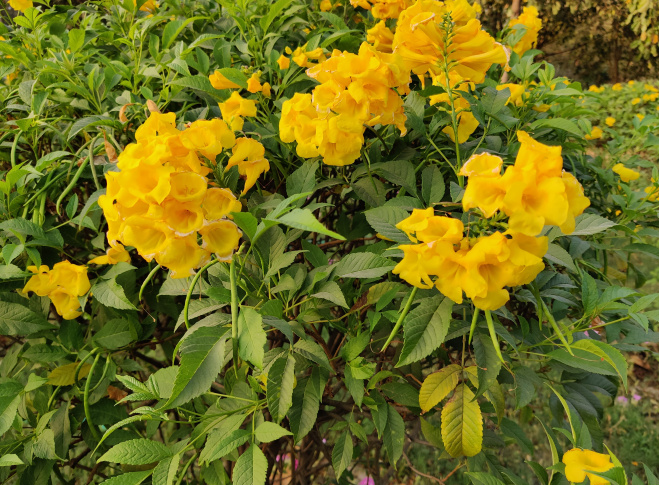The Bahamas, an island country located in the Caribbean, is known for its white-sand beaches, crystal-clear waters, and stunning coral reefs. But did you know about the Bahamas National Flower? The yellow elder, also known as Tecoma stans, is the national flower of the Bahamas. This article will delve into the history and significance of the yellow elder as the national flower of the Bahamas, its characteristics, cultural and historical uses, and how it contributes to the ecosystem.
The yellow elder, known scientifically as Tecoma stans, is a flowering shrub that is native to Central and South America. It is a popular ornamental plant in the Caribbean, and it is the national flower of the Bahamas. The plant is a member of the Bignoniaceae family and is also known as the yellow trumpet flower, ginger-thomas, and esperanza.
History and Significance of the Yellow Elder as the Bahamas National Flower
The yellow elder became the national flower of the Bahamas in 1972, replacing the Lignum vitae. The decision to change the national flower was made to reflect the country's culture, history, and landscape. The yellow elder was chosen because it is native to the Bahamas, and it symbolizes the beauty, strength, and resilience of the Bahamian people.
Characteristics of the Bahamas National Flower
The yellow elder is a deciduous or semi-evergreen shrub that can grow up to 25 feet tall. It has long, slender branches and green, glossy leaves that can reach up to 15 inches in length. The plant produces clusters of bright yellow trumpet-shaped flowers that are about 2 inches wide. The flowers bloom in the spring and summer and attract pollinators such as bees, butterflies, and hummingbirds. The plant also produces long, slender seedpods that contain many small seeds.
Cultural and Historical Uses of the Yellow Elder
The yellow elder has been used for various cultural and historical purposes in the Bahamas. The plant's flowers have been used to make a tea that is believed to have medicinal properties. The tea is used to treat colds, flu, and fever. The plant's bark has also been used to make a remedy for toothache. The bark is boiled in water, and the liquid is used as a mouthwash or gargle.
The yellow elder has also been used as a decorative plant. The flowers are used to make wreaths, garlands, and other decorative items. The plant is also used in landscaping and is commonly found in gardens and public spaces throughout the Bahamas.
The Yellow Elder in the Ecosystem
The yellow elder plays an important role in the ecosystem of the Bahamas. The plant is a host to various insects and provides food and shelter for pollinators. The plant's seeds are also an important food source for birds and other animals. The plant is also used in erosion control because of its deep roots, which help to hold the soil in place.
How to Grow Yellow Elders
The yellow elder is a low-maintenance plant that is easy to grow. It prefers full sun but can tolerate some shade. The plant prefers well-draining soil and should be watered regularly. The plant can also be propagated through stem cuttings or by seed. To propagate through cuttings, take a 6-inch stem cutting and remove the leaves from the lower half of the stem. Dip the cut end of the stem in rooting hormone and plant it in a well-draining potting mix. Keep the soil moist and the cutting in a bright location but out of direct sunlight. Once the cutting has developed roots, it can be transplanted into the ground.
Interesting Facts about Bahamas National Flower
- The yellow elder is also the state flower of the U.S. Virgin Islands.
- In Mexico, the yellow elder is used in traditional medicine to treat a variety of ailments, including arthritis and diabetes.
- The yellow elder is a popular plant in xeriscaping, which is a landscaping method that uses drought-tolerant plants to conserve water.
- The yellow elder is also used in the production of natural dyes.
- The flowers of the yellow elder are edible and can be used to garnish salads or desserts.
Conclusion
The yellow elder, the national flower of the Bahamas, is a beautiful and resilient plant that symbolizes the strength and beauty of the Bahamian people. It has many cultural and historical uses and plays an important role in the ecosystem. Growing yellow elders is easy and rewarding, and it can add a touch of tropical beauty to any garden or landscape.
FAQs
- What is the scientific name of the yellow elder?
The scientific name of the yellow elder is Tecoma stans.
- What is the significance of the yellow elder as the national flower of the Bahamas?
The yellow elder symbolizes the beauty, strength, and resilience of the Bahamian people.
- How do you propagate yellow elders?
Yellow elders can be propagated through stem cuttings or by seed.
- What is xeriscaping?
Xeriscaping is a landscaping method that uses drought-tolerant plants to conserve water.
- Are the flowers of the yellow elder edible?
Yes, the flowers of the yellow elder are edible and can be used to garnish salads or desserts.
References
- "Tecoma stans." Missouri Botanical Garden, http://www.missouribotanicalgarden.org/PlantFinder/PlantFinderDetails.aspx?kempercode=b624.
- "Tecoma stans." University of Florida, IFAS Extension, http://edis.ifas.ufl.edu/fp632.
- "The National Flower of the Bahamas." The Bahamas Weekly, 7 July 2012, https://www.thebahamasweekly.com/publish/government/The_National_Flower_of_The_Bahamas_printer.shtml.
